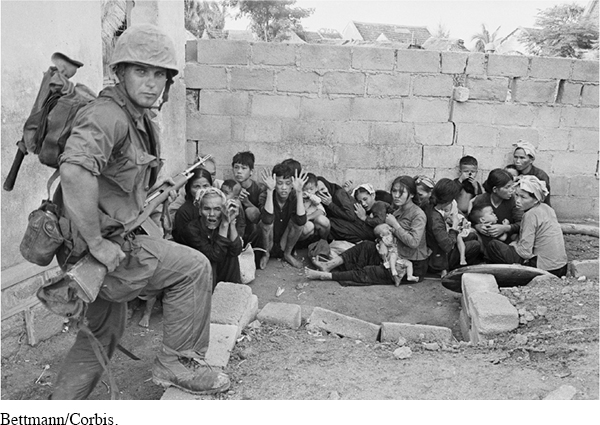The American Promise: Printed Page 841
The American Promise, Value Edition: Printed Page 763
The American Promise: A Concise History: Printed Page 870
The Americanized War
The American Promise: Printed Page 841
The American Promise, Value Edition: Printed Page 763
The American Promise: A Concise History: Printed Page 870
Page 841Military success in the Dominican Republic no doubt encouraged the president to press on in Vietnam. From 1965 to early 1968, the U.S. military presence grew to more than 500,000 troops as it escalated attacks on North Vietnam and on its ally, the National Liberation Front, in South Vietnam. To minimize protest at home and avoid provoking Chinese or Soviet involvement, Johnson expanded the war slowly. “I’m going up old Ho Chi Minh’s leg an inch at a time,” he gloated.

Eventually, U.S. pilots dropped 643,000 tons of bombs on North Vietnam and more than twice that amount in the South, a total surpassing all the explosives the United States dropped in World War II. The North Vietnamese withstood monthly death tolls of more than 2,000 from the bombing. “They turned their hatred into activity,” said one North Vietnamese about his comrades, whose ingenuity and sheer effort helped compensate for the destruction of transportation lines, industry sites, and power plants. (See “Making Historical Arguments: Why Couldn’t American Bombing Achieve Victory in Vietnam?”)In South Vietnam, the massive U.S. bombing campaign destroyed villages and fields, alienating the very population that the Americans had come to save and turning the former leading rice producer into a rice importer.
On the ground, General William Westmoreland’s strategy of attrition was designed to seek out and kill the Vietcong and North Vietnamese regular army. Because there was no fixed battlefront, helicopters carried troops to conduct offensives all over South Vietnam, and officials calculated progress not in territory seized but in “body counts” and “kill ratios”—the number of enemies killed relative to the cost in American and ARVN lives. “To win a battle, we had to kill them,” explained Lieutenant Frederick Downs Jr. “For them to win, all they had to do was survive.” After U.S. troops fought and bled to take ground, the enemy would withdraw, only to come back whenever they liked. The Americans “never owned anything except the ground they stood on.” And even though U.S.-ARVN forces achieved high kill ratios, North Vietnam sent in or recruited new Communist forces faster than they could be eliminated.